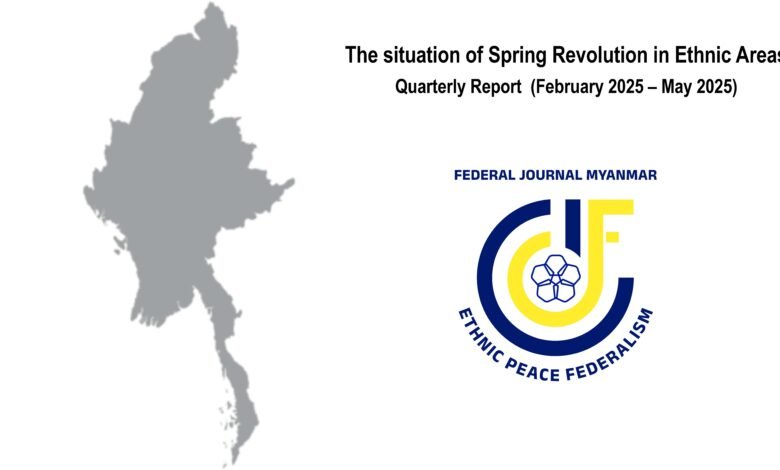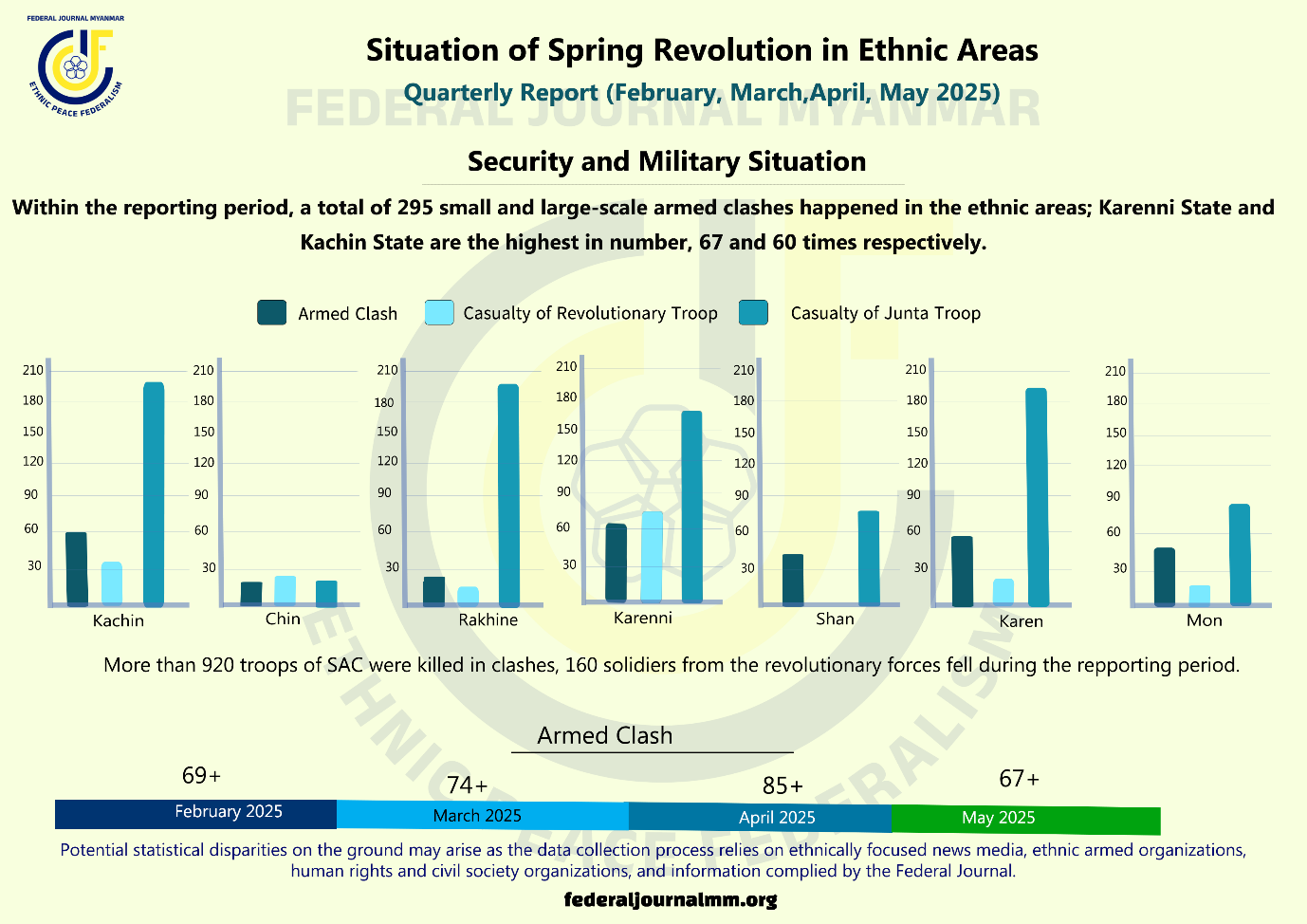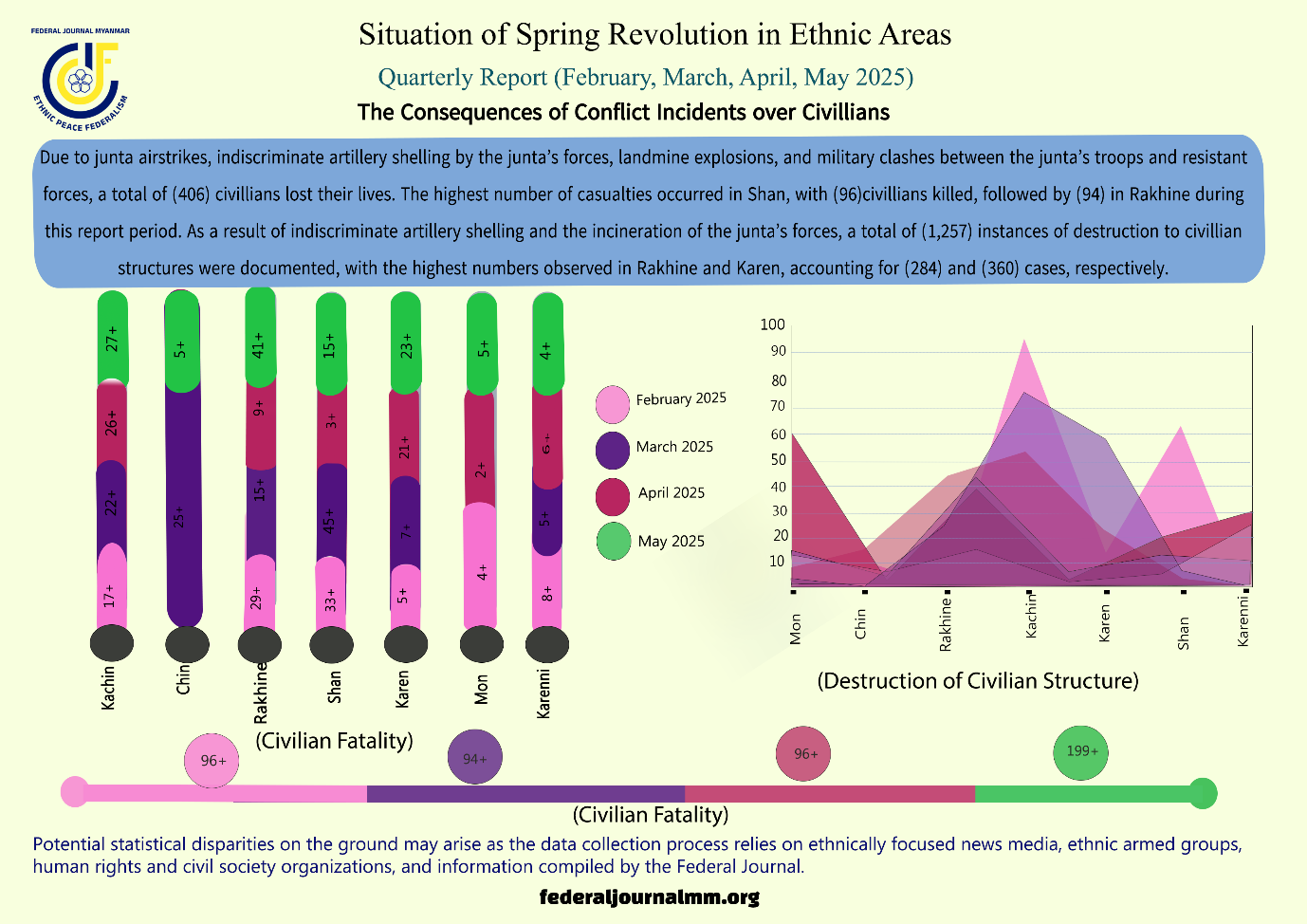
The situation of Spring Revolution in Ethnic Areas
Quarterly Report (February 2025 – May 2025)
The Federal Journal-Myanmar gathers information and publishes situational reports monthly on public activities, movements and coordination of the ethnic peoples in resisting the military junta in Myanmar. By this time, the report focused on political dynamic and conflict development in the past four months (from February 2025 – May 2025) by examining about casualties in both sides (the junta troops and resistant forces) due to conflict incidents, destruction of civilian structures due to the Junta’s airstrikes, operation and shelling, displacement, the captured outposts and towns of SAC by revolutionary groups and development of administrative or political coordination bodies in Ethnic areas.
Part (I)
- Armed Clashes and casualties in both sides

In the past four months from February 2025 to May 2025, the total of 295 armed clashes was documented which occurred between the SAC’s troops and resistant forces. Karenni state was the region where the most conflict incidents happened with the total of 67 times, followed by Kachin state with 60 times and Karen state with 55 times, Shan state with 43 times, Mon state with 34 times, Rakhine state with 21 times and Chin state with 15 times respectively. In those four months of armed conflicts, at least 920 of the junta troops were killed and about 160 fighters from resistant forces gave their lives for the success of revolution.
- Kachin state
In the past four months, during the armed conflict between the junta troops and joint forces of KIA and PDFs, at least 206 troops of SAC were reportedly killed and 35 soldiers from the revolutionary gave their lives for freedom.
Between February and May 2025, clashes occurred between SAC troops and the KIA in Kachin State. In the military operation to seize Bhamo town, the joint forces of the KIA were able to capture the following units during February: Myanmar military’s Battalion 6007, Artillery Battalion 366, Tank Unit 5014, Airfield Unit, and Infantry Battalion 236.Although the Military Council announced a ceasefire, ground military operations and aerial bombing attacks continued in Kachin State. On May 20, the KIA successfully shot down a helicopter of the Military Council that was reinforcing troops in the area of the Bhamo town battle.
- Chin state
In Chin state, it was reported that 20 soldiers of SAC were killed by Chin resistant forces in the previous four months conflict incidents in Chin state and 21 freedom fighters gave their lives for the success of revolution from resistant side.
In Chin State, Chin Brotherhood operation was successful and seized the Falam town in April. Falam become another captured town of CB in Chin state. In May, clashes erupted in the village of Mualpi in Tedim Township between the Chin defense joint forces including CDF-CDM-Siyin and the SAC troops because SAC troops were advancing from Kalay town toward the Chin hills. In areas under the control of resistance forces such as Mindat, Kanpetlet and Matupi Townships, the SAC frequently carried out aerial attacks.
- Shan state
In the past four months, during in the armed conflicts in Shan state between SAC and joint force of resistant groups, it was reported that about 70 SAC troops were killed.
In Shan State, the TNLA (Ta’ang National Liberation Army) launched a heavy assault on the headquarters of the SAC’s artillery battalion in Nawnghkio Township. In the southern part of Shan State, frequent clashes occurred between the Military Council, the Pa-O National Organization (PNO) People’s Militia, and resistance forces in Hsi Hseng Township. Intense fighting also took place in the Moe Bye area between the Military junta troops and the Karenni Nationalities Defense Force (KNDF). In April, the Myanmar Military resumed offensives operation which aimed at regaining control of Moe Bye town and villages in Shan State. Additionally, on April 17, Military junta officers, accompanied by Chinese government representatives, held tripartite talks with the MNDAA (Myanmar National Democratic Alliance Army) in Lashio, a town under MNDAA control. In May, fighting continued between the Military junta and TNLA in the Shan-Karenni border area, particularly around Pekhon, and clashes also erupted in southern Shan’s Naung Shwe area between the Military Council troops, the PNO militia, and resistance forces.
- Karenni state
In the past four month of fighting in Karenni state between SAC and the joint force of Karenni state, it was reported that at least 170 SAC troops were killed and 73 resistant forces fell in those battles.
In the Karenni region, intense clashes occurred between the KNDF, Karenni-based joint defense forces, and the Military junta in the Shan-Karenni border areas, Bawlakhe, Demoso, Pekhon and Moe Bye townships.The Karenni Army (KA) seized the Military junta outposts known as Point 5416 (a tactical base) and Taung Katoe camp located along the Thai-Karenni border.The Wanmalan base, a strategic Military outpost of SAC, was captured by the Karenni joint resistance forces on March 31. During April, the Military junta carried out heavy airstrikes in Karenni areas including the townships of Hpruso, Mese, and Loikaw. In May, resistance forces successfully seized SAC outposts in Bawlakhe Township of the Karenni region.
- Karen state
In the past four months, it was documented that 196 members of SAC were killed and 18 members of resistant groups in the fighting between joint force of revolution groups called Karen National Liberation Army – KNLA and People Defense Force -PDF and the military junta.
In the Karen region, clashes occurred between the Karen National Liberation Army (KNLA), Karen joint defense forces, and the Military junta forces in the areas of Kawkareik, Hlaingbwe Township, and Tan Taung Gyi region. The KNLA and joint forces seized two military checkpoints, including the Na Swe Pin gate camp led by Military junta’s Battalion 560, in Nyaung Lay Pin District. Additionally, the KNLA and allied forces captured the Khalae Dae camp in Hlaingbwe Township on March 26, and the Pu Lu Tu camp in the territory of Battalion 22 on March 14. In April, the KNLA successfully seized the SAC’s Thi Hta No. 1 strategic base and the Lay Kaw (Mawngala) camp in Nabule Township. In May, the KNLA and KNDO joint forces launched renewed offensives and seized the Maw Kwi Lu camp where Light Infantry Battalion 24 troops were stationed, as well as the Ta Nyar Kyo strategic base where Battalion 24 and Artillery Battalion 311 were based.
- Mon state
In the past four months from February 2025 to May 2025, it is reported that at least 88 SAC troops were killed in the fighting between Mon revolution forces and the Myanmar military junta and 7 revolutionary members were also fell in armed conflict.
In the Mon region, clashes occurred between the Military Council and joint resistance forces including the New Mon State Party’s Anti-Dictatorship faction (NMSP-AD) and the Mon State Revolutionary Force (MSRF). In the area of Bilin Township, within one month, the joint forces comprising the National Defense Force Battalion (27), the Tapinshwehti Battalion, the Maha Dagon Battalion, the Naga Battalion, the Taungnyo Battalion, the KNLA, PDF, BPLA, FFD Battalion, LDF, Pakafa (Bilin), and other allied revolutionary groups seized Meepale strategic base of the military junta.
- Rakhine state
In the past four months from February 2025 to May 2025, it was reported that 170 SAC troops died in the fighting between AA and SAC.
In Rakhine State, the Arakan Army (AA) launched simultaneous offensives in February
targeting the No. (32) Police Battalion based in Kyaukphyu and the Dhanyawaddy Naval Base.
Moreover, heavy clashes took place in the Nat Yekan strategic base located in Ngape Township on the Rakhine–Magway border, as well as along the Yoma mountain range and areas near the Bago Region. On February 2, the Arakan Army successfully seized the Gote Sake village tower outpost, also known as the Microwave Base. In rural areas of Sittwe Township and several other villages across Rakhine State, the military regime has repeatedly carried out artillery shelling and airstrikes. Although a ceasefire was in place during April, hostilities resumed and intensified between the military junta and AA in Kyaukphyu Township. By May, the Arakan Army had successfully captured all military outposts in the Ann region.
- The Impact of Conflict incidents on Civilians
In the past four months from February 2025 to May 2025, at least 406 civilians were killed due to the airstrikes and indiscriminate artillery shelling of SAC, landmine in conflict areas and shot dead in the conflict incidents in ethnic areas. At least 1,257 houses were destroyed by torching, shelling into civilian resident areas in ethnic areas by SAC.

In the reporting period, it was reported that Shan state was the most civilian casualties with the number of 96, Rakhine state was the second most with 94, follow by Kachin state with 92, Karen state with 56, Chin state with 30, Karenni state with 27 and Mon state with 11 respectively.
While looking at the damage of civilian structures, Karen state was in the top with 360, Rakhine state with 284 as the second highest, Kachin state with 167 as the third highest, follow by Karenni state with 165, Chin state with 136, Shan state with 105 and Mon state with 40 respectively.
Part (II)
The Activities of State/ Ethnic Councils and Committee

- Mon State Federal Council – MSFC
The Mon State Federal Council (MSFC) formed the Mon State Health Council by uniting six healthcare representation groups comprising Civil Disobedience Movement (CDM) medical doctor and revolutionary health workers operation in Mon State. The council includes representatives from: the medical doctor’s sector, nurses and midwives’ sector, public health and health supervision sector, medical technicians’ sector, and traditional medicine practitioners’ sector. Under MSFC’s leadership, the council has successfully conducted a six-month basic healthcare training program across Mon territories to enhance local medical capacity. MSFC and the Ye People’s Defense Force (YPDF) held strategic discussions to strengthen military cooperation until the complete overthrow of the military dictatorship. On 24 May, NMSP-AD and MLA merged to form the unified Ramanya Mon Army (RMA), making a major consolidation of revolutionary forces.
- Ta-ang Political Consultative Council – TPCC
Ta-ang political consultative council – TPCC recently convened its three-monthly plenary meeting in Ta’ang territory, attended by 74 representatives. The assembly reviewed 2024 progress reports, deliberated on the committee’s core principles, policies, and political stances, restructures membership, analyzed the current revolutionary situation and reformed future action plans. This meeting focused on governance development for twelve townships captured during operation 1027 by the PSLF/TNLA and also arrange of Ta’ang Revolution Government – a framework for establishing civilian-led administration in liberated areas. This gathering marks significant progress in institutionalizing Ta’ang revolutionary governance, combining military gains with political administration development in northern Shan State’s conflict-affected regions.
- Chinland Council
In 2024, the Chinland council formed Chinland’s governing bodies – including a Parliament, Government, and Supreme Court-under its new constitution. The Chinland Government has been managing public administration, healthcare, and education services, while the Parliament has passed laws to support the revolutionary movement. The Supreme Court is working to strengthen the legal system. The Chinland Council and Interim Chin National Consultative Council, both groups agreed to merge into a unified body called the Chin National Council- CNC. They will form a constitutional drafting committee to prepare the framework for the new CNC, aiming to create a stronger, more cohesive leadership structure for Chinland’s people. This consolidation represents an important step in building effective governance during Chinland’s revolutionary period.
- Karenni State Consultative Council
KSCC has successfully held an inclusive conference with representatives from all sectors of Karenni society with the interim governance arrangements for Karenni State. Through this, a people-centered administration has been established. KCC has formed township-level administrative bodies in all 17 townships across Karenni State including: Karenni State Interim Judiciary Law, The Karenni State Police Department, The karenni State Interim Parliament and a draft law on the Protection of Women from Violence. Under home affairs sector, KSCC is actively engaged in Community-based law enforcement, public security services, road safety and traffic regulation awareness programs and household data collection, border immigration check and the issuance of interstate passes (IP). Under education sector, KSCC has established 7 high schools, and trained 140 high school teachers. Under humanitarian sector, KSCC provides emergency response operations, food distribution programs and support for returning displaced families. On May 31, 2025, KSCC adopted the Karenni State Interim Humanitarian Policy.
References –
- Independence Medias
- Interim state consultative Councils
- Reports of ethnic human rights organization and CSOs
- Ethnic medias
- Exclusive interviews of the federal Journal Myanmar




